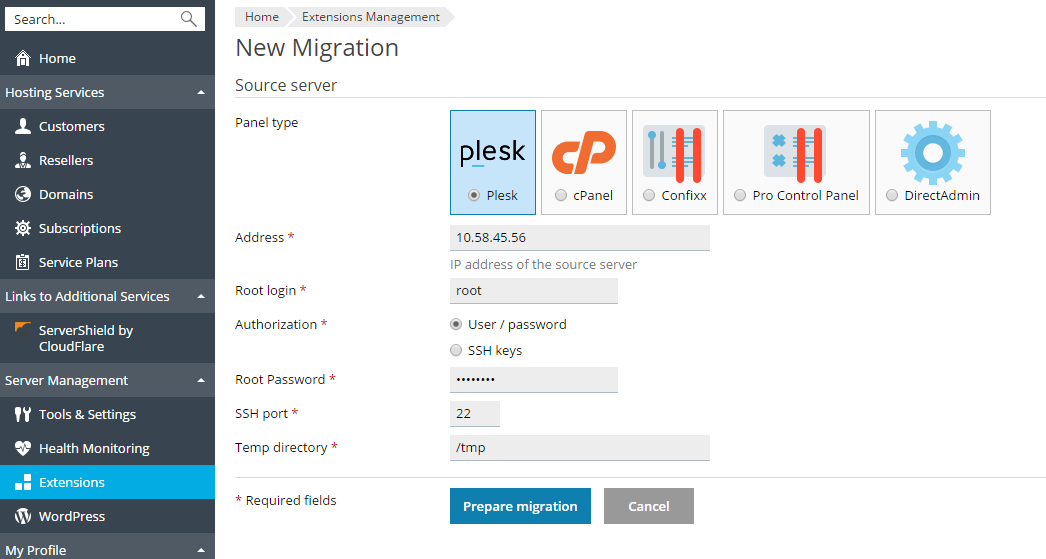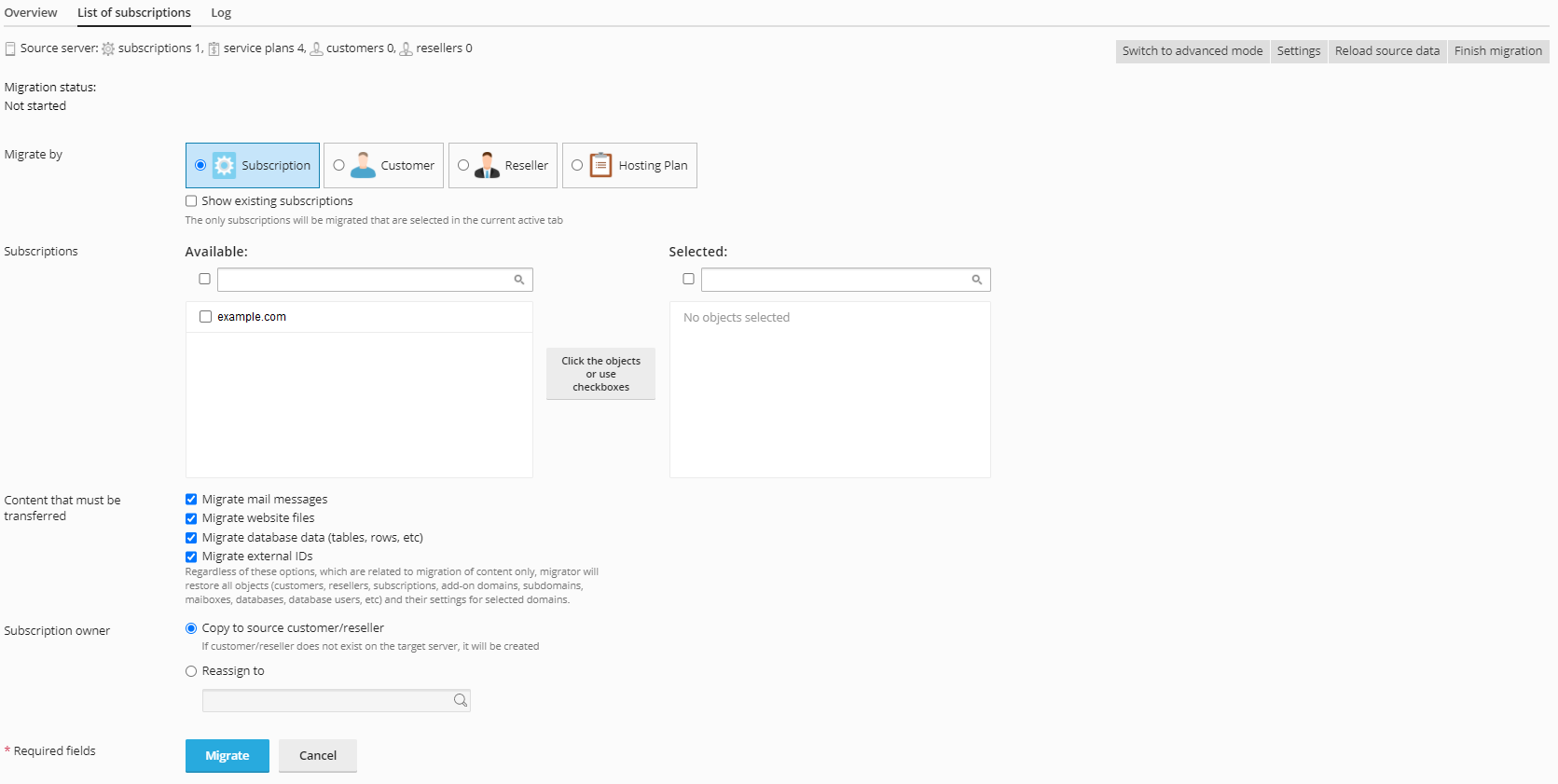Migrating via the Plesk Interface
-
Log in to Plesk on the destination server as the Plesk administrator.
-
Go to Server Management > Extensions > Plesk Migrator > Start a New Migration. If Plesk Migrator is unavailable, install it following the instructions here.
-
Select the hosting panel installed on the source server from the Panel type menu.
-
Specify the following:
- The source server’s IP address. If migrating from a Linux server, specify the SSH port as well (22 by default).
- (Plesk for Linux) The login and password of a root user on the source server. Alternatively, you can choose to authenticate via SSH keys. For details, refer to Authentication by SSH (Linux).
- (Plesk for Windows) The login and password of the built-in administrator accounts on both the source and the destination servers.
- The directory for storing temporary files on the source server (make sure there is enough free disk space available to store the dump of the largest database that will be migrated).
-
If migrating from a Windows-based server, specify the method for installing the RPC agent (an application enabling Plesk Migrator to gather data):
- Automatic (recommended). Plesk Migrator will try to deploy and start RPC agent on the source server using the built-in administrator account. In some cases, automatic deployment may fail (for example, due to firewall settings, or because the File and Printer Sharing or RPC services are disabled). If this happens, deploy the agent manually.
- Manual. A link to download the RPC agent package will be provided. Download the package and install the agent on the source server manually.
-
Click Prepare Migration to proceed to the next step. Plesk Migrator will attempt to fetch the data about the different objects (domains, subscriptions, customer/reseller accounts, and hosting plans) found on the source server. If the connection fails, double-check the source server information, make sure that the connection is not blocked by firewall, and try again.
Note that from this point onwards, you can leave the Migrator interface without losing your progress - the migration will remain in progress until you finish it explicitly. To continue from where you left off, click Server Management > Extensions > Plesk Migrator and then click the corresponding migration in the list.
-
You now find yourself on the List of subscriptions tab.
Here you must select the subscriptions to be migrated (note that you cannot migrate individual domains, the fewest number of objects you can migrate is a single subscription and all its domains). You can use one of four available filters:
- By Subscription. If you migrate a subscription owned by a customer or a reseller, the corresponding customer/reseller account will be migrated as well (unless a custom subscription owner is specified - see below). The hosting plan the subscription is based on will also be migrated.
- By Customer. If you migrate a customer account, all subscriptions owned by the account will be migrated together with the hosting plans they are based on.
- By Reseller. If you migrate a reseller account, all subscriptions owned by the account will be migrated together with the hosting plans they are based on. Note that migrating a reseller account does not automatically migrate the customer accounts owned by the reseller. If you select a reseller account and one or more customer accounts owned by that reseller for migration, the reseller’s ownership of the customer accounts will be preserved on the destination server.
- By Hosting Plan. If you migrate a hosting plan, all subscriptions based on the said plan will be migrated as well. If you migrate a hosting plan belonging to a reseller, said reseller will be migrated as well, plus all subscriptions based on the selected hosting plan together with the customers who own those subscriptions.
-
By default, Plesk also migrates additional content (email messages, website files, database tables, and external IDs). If you do not want to migrate any of that, clear the corresponding checkboxes.
Note: External IDs are IDs that link Plesk objects (for example, subscriptions, customers, or resellers) with external services. External IDs exist only if your Plesk is integrated with an external service (for example, a billing service like WHMCS). If such integration exists or you are not sure about it, keep the “Migrate external IDs” checkbox selected to migrate external IDs to the destination. Even if you actually have no external IDs, it will not hinder the migration in any way.
-
Select a custom subscription owner. By default, whenever a subscription owned by a customer or reseller is migrated, the corresponding customer or reseller account is created on the destination server as well. If you select a different subscription owner, the ownership of all subscriptions being migrated will be assigned to that account.
-
To change the migration settings, click Settings in the upper-right corner.
Here, the following controls are available:
- Adjust application settings. By default, during migration Plesk attempts to make changes to the configuration files of a number of popular web applications to make them operable on the destination server. Clear the checkbox if you want to make the changes manually. Leaving this option enabled will increase the migration time.
- Apache restart interval (Plesk for Linux only). Restarting the web server on the destination server is necessary for the migrated domains to become available over the network. Make sure not to set this value too low (less than 300 seconds is not recommended), as all hosted domains become temporarily unavailable every time the web server is restarted.
- Run post-migration checks. By default, after the migration is finished, Plesk performs a number of automated tests to identify potential issues with the migrated domains. Clear the checkbox if you do not want the tests to be run. Leaving this option enabled will increase the migration time.
-
When you are satisfied with the list of subscriptions to migrate and the migration options, click Migrate to proceed. Plesk will run pre-migration checks to detect potential issues and display a report.
We advise you to fix the detected issues (if any) before continuing with the migration. Make the necessary configuration changes, then click Refresh to re-run the tests.
-
When the pre-migration check returns a clean result, click Start migration to begin migrating. Once a migration is underway, you can monitor its progress on the Overview tab.
-
As subscriptions are being migrated, status reports will be displayed for every subscription for which the migration was either completed successfully, or failed.
- The
icon indicates that the migration was completed successfully.
- The
icon indicates that the migration was completed with errors. Click [Details] to see the list of issues that occurred during the migration.
- The
icon indicates that the migration failed. Click [Details] to see the list of issues that occurred during the migration.
- The
-
If you want to perform an additional sync of a subscription’s content after the migration is finished, click [Re-sync] next to the subscription’s name.
-
If you want to migrate additional subscriptions from the source server, return to step number seven. Otherwise, unless you plan to migrate from the same source server again in the near future, you can click Finish migration to remove it from the list of ongoing migrations.








 icon indicates that the migration was
completed successfully.
icon indicates that the migration was
completed successfully. icon indicates that the migration was
completed with errors. Click [Details] to see the list of
issues that occurred during the migration.
icon indicates that the migration was
completed with errors. Click [Details] to see the list of
issues that occurred during the migration. icon indicates that the migration failed.
Click [Details] to see the list of issues that occurred during
the migration.
icon indicates that the migration failed.
Click [Details] to see the list of issues that occurred during
the migration.